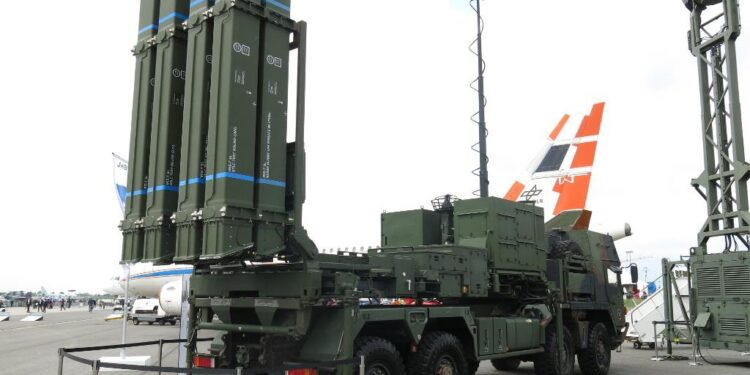Slovenia has officially expanded its air defense capabilities with the recent order of two additional IRIS-T SLM air defense batteries, underscoring the country’s commitment to strengthening its national security amid evolving regional threats. The acquisition, announced by defense officials, signals Ljubljana’s ongoing efforts to modernize its military infrastructure with advanced, interoperable systems designed to protect Slovenian airspace. This latest purchase builds on previous investments in the IRIS-T system, reflecting a broader trend among European nations to enhance short- and medium-range missile defense amid rising geopolitical tensions.
Slovenia Expands Air Defense Capabilities with Acquisition of IRIS T SLM Batteries
Slovenia has taken a significant step to bolster its national air defense by acquiring two additional IRIS-T SLM batteries. This procurement enhances the country’s ability to detect and intercept aerial threats with a state-of-the-art surface-to-air missile system renowned for its rapid response and precision targeting. The IRIS-T SLM, developed by Diehl Defence, is designed to counter a wide range of modern threats, including cruise missiles, drones, and aircraft, making it a pivotal asset for Slovenia’s evolving defense strategy.
Key features of the IRIS-T SLM system include:
- 360-degree coverage with multi-target tracking
- High maneuverability and engagement accuracy
- Integrated radar and command-control interoperability
- Effective against low- and high-altitude threats
| Parameter | Specification |
|---|---|
| Range (km) | 40 |
| Missile Speed | Mach 3+ |
| Engagement Altitude | Up to 20,000 meters |
| Reaction Time | Less than 10 seconds |
This defense upgrade aligns with Slovenia’s commitment to regional security and NATO obligations, further integrating its military infrastructure with advanced European defense technologies. The addition of the IRIS-T SLM batteries not only elevates the country’s air defense posture but also strengthens deterrence against increasingly sophisticated aerial threats across its airspace.
Strategic Implications of Slovenia’s Enhanced Missile Defense in the Regional Security Landscape
The acquisition of two additional IRIS-T SLM air defense batteries signifies a substantial shift in Slovenia’s defense posture, reinforcing its role as a pivotal security actor within the Western Balkans and Central Europe. By expanding its missile defense capabilities, Slovenia is not only enhancing national protection against emerging aerial threats but also contributing to the broader NATO air defense network. This move strategically positions Slovenia as a more resilient partner in collective defense, capable of deterring hostile missile and drone incursions, particularly amid increasing regional tensions and the evolving security dynamics influenced by Russia’s assertiveness in Eastern Europe.
From a regional perspective, Slovenia’s upgrade cascades into several strategic benefits:
- Augmented interoperability with allied forces, enabling coordinated responses in multi-domain operations.
- Strengthened deterrence posture that discourages potential aggression through enhanced situational awareness and rapid engagement capabilities.
- Rebalancing of military power in the region, compelling neighboring states to reconsider their own defense strategies.
| Capability Aspect | Strategic Benefit |
|---|---|
| Extended missile engagement range | Broader airspace control and early threat neutralization |
| Advanced sensor integration | Improved detection and tracking of low-observable targets |
| Network-centric warfare compatibility | Seamless data sharing with NATO command structures |
Ultimately, Slovenia’s procurement reflects a deliberate strategic choice to amplify its defense infrastructure, signaling both a commitment to NATO obligations and an acknowledgment of the complex challenges shaping the regional security environment for years to come.
Recommendations for Optimizing Integration and Deployment of New Air Defense Systems
To maximize the operational effectiveness of the newly acquired IRIS-T SLM air defense batteries, it is essential to adopt a phased and adaptive integration strategy. Prioritizing interoperability with existing legacy systems ensures seamless communication and coordinated threat response across different defense layers. Emphasis should be placed on regular joint training exercises simulating realistic combat scenarios, enabling personnel to master system capabilities under pressure. Additionally, incorporating advanced cyber defense protocols will protect critical network nodes from potential electronic warfare attacks during deployment.
Optimization also depends on meticulous logistical planning and maintenance support to sustain prolonged operational readiness. Establishing a centralized command and control hub equipped with real-time data analytics can significantly enhance decision-making speed and accuracy. The following table outlines key focus areas and recommended actions to streamline the deployment process:
| Focus Area | Recommended Action |
|---|---|
| System Integration | Conduct compatibility testing with NATO networks |
| Training | Implement scenario-based drills bi-annually |
| Cybersecurity | Deploy adaptive firewalls and intrusion detection |
| Logistics | Pre-position spare parts for rapid repairs |
| Command & Control | Integrate AI-assisted target tracking software |
Insights and Conclusions
The decision by Slovenia to acquire two additional IRIS-T SLM air defense batteries underscores the country’s commitment to bolstering its national security amid an increasingly complex regional security landscape. This move not only enhances Slovenia’s short- and medium-range air defense capabilities but also reflects broader trends in Central and Eastern Europe, where NATO members continue to modernize their military arsenals in response to emerging threats. As the deployment of these advanced systems progresses, attention will remain on how Slovenia integrates them into its existing defense framework and collaborates with allies to maintain stability in the region.
















